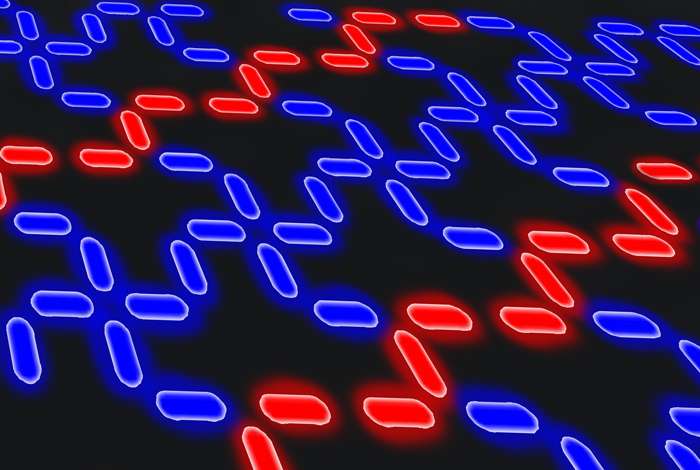Tiny magnets could work in sensors, information encoding

Scientists from Los Alamos National Laboratory, in collaboration with a group at the University of Illinois at Urbana-Champaign, the Lawrence Berkeley National Laboratory's Advanced Light Source and with other researchers nationwide, have realized a nanoscale, artificial magnet by arranging an array of magnetic nano-islands along a geometry that is not found in natural magnets. Their paper "Emergent reduced dimensionality by vertex frustration in artificial spin ice" appears on the journal Nature Physics website today.
"Each nano-island is similar to a refrigerator magnet, with a north and a south pole at its tips," said Los Alamos physicist Cristiano Nisoli. "Unlike a refrigerator magnet, however, it can change its magnetization by flipping north and south, through use of either applied fields or thermal fluctuations. But because these islands are brought together, they interact, and this interaction induces a collective behavior that can be exploited for emergent properties."
Applications might range from general magnetism, such as developing sensors, to information encoding.
"This magnet is explicitly designed to exhibit dimensional reduction: in this case going from a two-dimensional behavior to a one-dimensional one," said Nisoli. "As temperature is lowered to room temperature, the magnet crosses over from being a 'standard' magnet into a new and exotic state where it exhibits so called 'dimensional reduction' with alternating ordered and disordered stripes, with distinct kinetic behaviors among the two. The ordered stripes are static, while the disordered ones flip thermally."
Interestingly, the behavior is not random, Nisoli notes, as the stripes and their behavior can be predicted via a 1D Ising model –the very first tool to understand phase transition, which theoretical physicists have been studying for about 80 years—he said.
Multidimensional, flipping nanomagnets, what's not to love?
Magnetic materials that exhibit exotic/useful behaviors are rare, found by chance in nature, and most of their interesting properties happen at temperatures that are so low as to limit technological applications.
Fabricating magnets with desired properties that are functional at useful temperature ranges is thus relevant for science, technology and national security. "This work belongs to an effort toward bottom-up design of magnets whose desired properties and emergent behaviors can be designed," Nisoli said.
While this effort has provided a basic science advance by illustrating how emergent behaviors can be explicitly designed into a nanostructure, it can also lead to a material-by-design approach to magnetism that exploits the collective behavior of nano magnets.
Background
This research is part of an effort that started in 2006, noted in a cover story in the journal Nature [Nature 439 (7074), 303-306 January 19, 2006]. At that time considerable research had been already performed on the magnetic properties of isolated nano-structures of different shapes.
"Our idea was to put these nano magnets together and make them interact to exploit their collective behavior and create artificial magnets that do not exist in nature," said Nisoli.
Results were encouraging and but the team immediately encountered various challenges: how to randomize these systems, how to produce consistent magnetic ensembles, and so on. The work was noticed around the world and more scientists began working on these new structures (so far there are groups in USA, Germany, Switzerland, England, Italy, France, Spain, Australia, Russia, Brazil, working on this), which was particularly useful, Nisoli noted, as it lead to faster development and new ideas.
Recently, with new experimental protocols that allowed for thermally active materials, [Nature 500 (7464), 553-557, 2003] Nisoli began designing dedicated topologies based on a new level of frustration [New Journal of Physics 15 (4), 045009, 20013]. Indeed frustration is an essential ingredient in the design of these materials.
"Interestingly, much like frustration in life, frustration in artificial spin ice materials arises from the fact that many different constraints cannot be satisfied at the same time. And as in life, from frustration comes compromise, which implies that the material is free to explore many different phases," Nisoli said. "By designing these constraints and thus the engineering the frustration of the magnet, we can obtain the desired emergent behaviors."
More information: Marco Tulio Angulo et al. Network motifs emerge from interconnections that favour stability, Nature Physics (2015). DOI: 10.1038/nphys3402
Journal information: Nature Physics , Nature , New Journal of Physics
Provided by Los Alamos National Laboratory




















